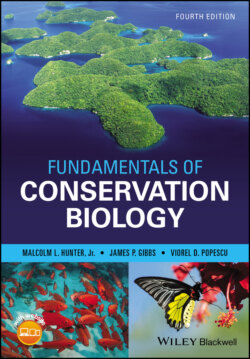Читать книгу Fundamentals of Conservation Biology - Malcolm L. Hunter Jr. - Страница 63
Scientific and Educational Values
ОглавлениеThe world is a complex place, but our knowledge of it is increasing all the time, and some of the credit goes to our fellow inhabitants (Fig. 3.9). There are many examples. Birds offered both the inspiration to fly and a model from which to learn, and, similarly, the ability of bats to fly in the dark inspired the development of sonar and radar. Mendel’s famous peas opened the door to genetics, and the convenience of working with Drosophila fruit flies has greatly facilitated genetic research. Much of what we know about human developmental biology we learned from watching salamander eggs. Many anthropologists who seek insight into human social interactions study our nearest relatives: all the other members of the primate order. Engineers, biologists, and others continue the quest to develop technology inspired or informed by nature, an endeavor often called biomimicry (Harman 2014). Some of the latest examples are manifested at the atomic and molecular scale with the structure of viruses and bacteria furthering advances in nanotechnology (Pacheco‐Torgal and Jalali 2011) (Fig. 3.10).
Figure 3.9 Other organisms teach us about our world. Here biologists attach a radio‐transmitter to a giant armadillo in Emas National Park Brazil.
(Courtesy of Leandro Silveira)
Figure 3.10 (Left) This person climbed up and down almost 10 m of glass, at times carrying a 20 kg load. How is this possible? He used hand‐held paddles made from novel polymer microstructure technology inspired by the toes of geckos. (Right) Geckos can climb smooth surfaces because their toes have bundles of “hairs” that stick to the surface by essentially sharing electrons with it. This nano‐scale technological innovation has many potential applications, from simple jobs like replacing car windshields to capturing space junk or replacing ropes and ladders for rescue operations in urban environments.
(DARPA/Public domain [Left]; Mr.B‐king/Shutterstock [Right])
Of course, scientific inquiry is just an advanced form of the intellectual curiosity about the world that begins in infancy. Our education would suffer greatly without a diverse world to explore, without bean seeds to plant and follow to germination, without frog eggs to watch develop into tadpoles. Whether we want to learn about ourselves or the world we share with other species, we need models to observe.
